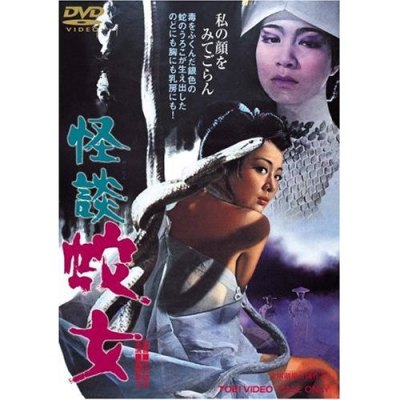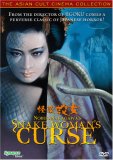| Reviews & Columns |
|
Reviews DVD TV on DVD Blu-ray 4K UHD International DVDs In Theaters Reviews by Studio Video Games Features Collector Series DVDs Easter Egg Database Interviews DVD Talk Radio Feature Articles Columns Anime Talk DVD Savant Horror DVDs The M.O.D. Squad Art House HD Talk Silent DVD
|
DVD Talk Forum |
|
|
| Resources |
|
DVD Price Search Customer Service #'s RCE Info Links |
|
Columns
|
|
|
Snake Woman's Curse
Reportedly, Criterion had to license upwards of two dozen other Shintoho genre films just to get rights on Jigoku. These same titles were released in Japan in 2001 as pricey DVDs (about $45 each) via Happinet Pictures, but the good news was that all of them included English subtitles. The titles included several other Nakagawa pictures (as well as some crackling little Teruo Ishii thrillers), and though only die-hard Nakagawa admirers in the West have been able to experience them so far, their availability has only fueled the director's reputation. As with western world genre filmmakers like Roger Corman, it's easy to under- or overrate Nakagawa's talents - his legitimization by Criterion now swinging the pendulum toward the latter - and Snake Woman's Curse (Kaidan - hebi-onna, or "Ghost Story - The Snake-Woman," 1968) is no more or less than a terrifically atmospheric, slickly made horror film, perfect viewing for the Obon holiday in Japan (the time when kaidan eiga, or "ghost story movies," are most popular)...or as Halloween viewing in America.
The film follows the well-established path of virtually all traditional kaidan eiga: either an ambitious husband, usually a samurai, is unfaithful to his wife that either is murdered or commits suicide; or a cruel landowner or lord abuses the power he holds over local peasants. An hour or so into the picture, the audience is more than ready to see these villains get their comeuppance, always in the form of a vengeful ghost or ghosts. Snake Woman's Curse, set in a remote seaside village sometime during the Meiji era, follows the latter path.
Onuma (Seizaburo Kawazu) is the patriarch of an absolutely heartless family dominating desperately poor tenant farmers. When farmer Yasuke (Ko Nishimura) works himself into an early grave, Onuma orders his wife, Sue (Chiaki Tsukioka), and their virginal daughter, Asa (Yukiko Kuwabara), work off their 10-year debt as indentured servants at the family estate - in 4:00am to 9:00pm shifts, no less. There they encounter more Onuma family members that make Sansho the Bailiff look like Daddy Warbucks. Onuma's jealous wife (Akemi Negishi) blames Sue for her husband's clumsy attempts to seduce her, while Asa must contend with their piggish, horny son, Takeo (Shingo Yamashiro), who plots to rape the poor girl. Add to that is the estate's equally malevolent foreman, Saiji (familiar Toei face Hideo Murota). Before long, visions of ghosts and ominous omens involving snakes plague the Onuma family.
Nakagawa had a long career in Japan, directing nearly a hundred features beginning in 1934. In fact he made films of all kinds: dramas, period films, thrillers. Indeed, before the war Nakagawa was chiefly known for his comedies with actors like Kingoro Yanagiya and, especially, Kenichi "Enoken" Enomoto (The Men Who Tread on the Tiger's Tail). After about 1949 Nakagawa worked mainly at Shintoho, a company that started out with lofty ambitions but which by the late-1950s was a kind of Allied Artists B-movie studio cranking out exploitative product. These included singularly right-wing war movies, potboilers about nude pearl divers, noirish thrillers - and horror movies. Nakagawa himself did a fairly wide range of films during this time, including the goofy The Woman Vampire (Onna kyuketsuki, 1959) and the effective Death Row Woman (Onna shikeishu no datsugoku, 1960), as well as low-budget but highly imaginative adaptations of famous Japanese ghost stories, most notably The Ghost of Yotsuya (Tokaido Yotsuya kaidan, 1959).
By contrast, Snake Woman's Curse, made at the financially robust Toei, has slicker production values, most obviously in the film's extensive location photography - most of the Shintoho ghost story movies used cramped soundstages even for exteriors. Pretty much though, it's Nakagawa doing what he did best: maximizing with a confident visual style a genre picture designed to scare as many people as intensely as possible.
Nakagawa delivers these shocks in the usual Japanese manner. Western audiences will generally be unaccustomed to the conventions of the genre, but that's not necessarily a bad thing, as they will find the relative unusualness of some of the horrors surprisingly creepy. It's to Nakagawa's credit that he can pull off a scene like the incredibly effective and haunting one where two dead spirits are reunited on a beach in broad daylight, moving toward one another in slow-motion, or that most of the shocks are achieved through ingenious though simple blocking and basic shock cuts. There is much and clever use of sound effects throughout, while Shunsuke Kikuchi's (Female Convict Scorpion: Jailhouse 41) score effectively juggles all the musical iconography associated with such films.
As actors, Kawazu and Negishi are especially good reactors, and their authentically terrified expressions enhance the horror, just as Kuwabara and Tsukioka engender our sympathies in their roles. Harking back to Nakagawa's days with Enoken, the film finds time for some comedy, notably Shunji Sayama's clownish servant Kame and Junzaburo Ban as the foolish village mayor.
Video & Audio
Snake Woman's Curse, in its original Toeiscope screen shape, looks splendid in a near-flawless 16:9 enhanced presentation both vivid and razor sharp. The opening titles are windowboxed, and the hues (originally Fujicolor) are accurately presented. The optional English subtitles are very good, though I wish either somewhere in the liner notes or on the film itself were complete credits. Overall a great transfer, however.
Extra Features
Jonathan M. Hall, who teaches Japanese cinema at the University of California, Irvine, provides an audio commentary. Primarily a literary reading, noting historical and cultural influences, it's obviously well-researched and informative, if you can get past all the film theory mumbo-jumbo, including discussions about such matters as "the position of the liminal" and "geo-temporal selections." There's a lot of good information, but some of his arguments tend to disregard the film's primarily commercial aspirations. For instance, he makes the case for Snake Woman's Curse as an example of "political cinema" (rich landowners exploiting poor peasants, etc.), but as mentioned earlier, the film is only following the well-worn path of nearly all kaidan eiga. The same argument could be made for nearly all B-Westerns, whose plots often revolved around cattle barons, bankers and the like trying to muscle in or cheat innocent settlers out of their land. As far as I know, no one's ever accused Yodelin' Kid from Pine Ridge of making weighty political statements.
The insert essay by University of Wawick Ph.D. candidate Alexander Jacoby is well-written but it does have its share of factual errors. He writes, for example, that The Snake Woman's Curse was Nakagawa's "first film in six years," suggesting a spotty post-Shintoho career. Though his career was slowing down somewhat, Nakagawa actually made six features during that time - Jacoby seems to have relied on the IMDb (often woefully incomplete with regard to Japanese movies), rather than first-hand Japanese references, for this misinformation. Update: Japanese film scholar Alexander Jacoby contacted this reviewer to graciously offer the following clarification and analysis of Nakagawa career at this point, and the reasons behind the confusion over his credits during the 1960s. He writes, "Mea culpa - I was indeed wrong to state that Snake Woman's Curse was Nakagawa's first film in six years. I had consulted Japanese sources to prepare my own Nakagawa filmography, but in doing so had negligently made an error in the dating of two films. Nakagawa continued to direct regularly until 1963, so I should have described Snake Woman's Curse as, at most, his first film in five years. Even this is true only if we restrict consideration to films on which Nakagawa served as full director. He is credited for supervision ("kanshu") on a 1966 project, Nihon o shikaru: Shata 0. So although it seems that he was not actually credited as director ("kantoku") on any film between 1963 and 1968, he nevertheless was not absent from the Japanese film industry during those years. I apologise to readers of my notes for misleading them."
A 16:9 enhanced Japanese trailer is full of spoilers but sells the film for what it is, promising something "extremely frightening" (!). (The subtitles mistranslate Kuwabara's name as "Sachiko," but Yukiko is the correct reading, at least according to Kinema Jumpo.) Chris D. provides a detailed text biography of Nobuo Nakagawa, and helped provide a wonderful collection of (16:9) poster art for many of the director's films.
Parting Thoughts
The great thing about this thing called DVD is that so many long sought-after foreign films, especially genre titles never given much respect in the early days of home video, can be given the kind of super-deluxe treatment Snake Woman's Curse enjoys. Highly Recommended.
Film historian Stuart Galbraith IV's most recent essays appear in Criterion's three-disc Seven Samurai DVD and BCI Eclipse's The Quiet Duel. His audio commentary for Invasion of Astro Monster is now available.
|
| Popular Reviews |
| Sponsored Links |
|
|
| Sponsored Links |
|
|
| Release List | Reviews | Shop | Newsletter | Forum | DVD Giveaways | Blu-Ray | Advertise |
|
Copyright 2024 DVDTalk.com All Rights Reserved. Legal Info, Privacy Policy, Terms of Use,
Manage Preferences,
Your Privacy Choices | |||||||














